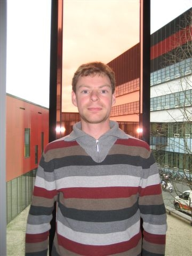Perovskite oxide heteroepitaxy strain and interface engineering
Promotion date: 4. Februari 2011
Promotor: Prof. Dr. Ing. Guus Rijnders and Prof. Dr. Ing. Dave Blank
Assistant promotor: Dr. Ir. Gertjan Koster
| Perovskite oxides are naturally suitable for heteroepitaxy. In this thesis, an exploration of the possibilities with strain and interface engineering is made for both the LaAlO3/SrTiO3 (LAO/STO) interface and the fully spin polarized metal La0.67Sr0.33MnO3 (LSMO). At first, the conducting interface between the two band insulators LAO and STO is studied. The main experimental result is that the expected electrostatic potential buildup in the LAO layer is not observed. This indicates that the most widely used model to explain the conductivity at the interface, the electronic reconstruction due to the polar discontinuity, is not applicable to the experiments. An alternative model for the conductivity is proposed. In LSMO thin films, the crystal structure is determined by the strain from the underlying substrate. With the choice of a specific substrate surface, the magnetic properties of the LSMO layer can be controlled. A model was developed which predicts the magnetocrystalline anisotropy. The model was verified with measurements of the magnetic anisotropy of LSMO thin films grown on different surfaces of NdGaO3 single crystal substrates. The use of LSMO in spintronic devices requires spin polarized conductivity at the interface. Due to interface reconstructions, generally the spin polarized conductivity is reduced at the interface. Interface engineering was applied to study and improve the properties of the LSMO. |
How would you describe your main contribution in your thesis project?
When I started, the most important issue was on LSMO spin polarized tunnelling. I applied theoretical outcomes, to improve the properties of substrates by growing them layer by layer, compensating for the expected side-effects. In this way these properties could be improved considerably, though other questions remained unsolved.
In LAO/STO interfaces, experimental results led to new theoretical insights. The field of subject is developing rapidly worldwide, and we contributed to a new way of thinking. Upcoming PhD-students within Mesa+ will work on it in the future.
How do theory and experiment intertwine in your thesis work?
In this field of research a lot of knowledge is already there. It is efficient and effective to read literature and theory carefully, and then bring it together in clever experiments.
As a scientist I like to look for a fruitful connection between theory and apply this to the experiments. Too often both worlds are divided. Positioning oneself in the middle of it is very exciting.
In what papers did you publish your results?
I am co-author of a number of publications in Physical Review B, Physical Review Letters, Nanoletters and Applied Physics Letters. The most important papers about the research in my thesis are yet to come, however.
What are your future plans?
At the moment, I am working as a post-doc to indeed write some extra publications, as mentioned before.
After that, I would like to remain in academic research. I did hesitate on this for a while. I guess working in industry doesn't suit me that well. I consider scientific challenges as an important part of my work and job satisfaction, so to say.
What, in your opinion, is important for Mesa+ to stay successful in the future?
Clustering of groups can be of prime importance for reaching interesting results. In my project, I had some good collaboration with research fellows, for example with members of the Quantum Transport in Matter Group.
Furthermore, talented post-docs can bring in challenging new visions on research. Nowadays these people too easily choose for renowned universities like Berkeley or Stanford. This is understandable, nevertheless, I believe, Mesa+ has lots to offer besides high-quality research, like great facilities, cleanroom expertise and working conditions, possibly even better than in the United States.
Also, of course, talented students, PhD's and staff are crucial.

